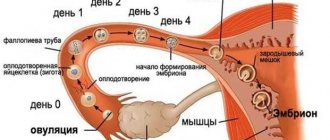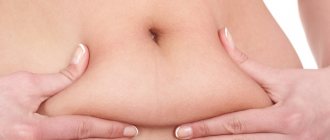Quote: It is generally accepted that a child makes his very first cry at birth. It turns out that this is not entirely true! According to Swedish scientists, the child speaks already in the womb. Anselm Linstrade, professor at the Stockholm Clinic of Gynecology, Embryology and Perinatology, says: “When examining a pregnant woman, the doctor, listening to the baby’s heart, tries to determine whether the child is developing correctly. For greater accuracy, we have recently begun to use an audiometer, which is good at picking up sounds of different frequencies. Unexpectedly for us, this device “detected” some strange sound waves. It couldn't be a heartbeat - its signals were on a different frequency. It was more like the sound of human speech. The tone changed, strange signals alternated. It seemed that the future baby was... talking! Of course, this is not speech in the usual sense - after all, the child swims in the amniotic fluid and makes the first sound only after birth. But sounds can be born not only in the vocal cords. Further observations confirmed this. When examining more than 200 women who were in the fifth or sixth month of pregnancy, the audiometer recorded these sounds in all cases. We even noticed an interesting pattern: usually the baby talks at least once an hour and especially often speaks at lunchtime. It also turned out that future girls are more talkative than boys - they “chat” almost twice as long. During multiple pregnancies - twins, triplets - children do not “speak” at the same time. They either give each other the floor, or... talk to each other!
Pregnancy is a special time when the expectant mother, expecting her baby, carefully monitors her feelings. Closer to the 30th week, many pregnant women notice the appearance of clicks inside the abdomen, which makes them worry. Basically, the phenomenon is not dangerous, since it is caused by physiological processes. However, similar sounds may indicate pathology, which is especially likely when additional symptoms are added.
Possible causes of clicking in the abdomen in late pregnancy
The exact reason for the appearance of gurgling and clicking in the abdomen in the later stages has not been established. Most opinions agree that by the end of pregnancy the baby becomes so large that a woman who listens carefully to herself hears the sounds that he makes during his intrauterine life - smacking or belching.
There is a version that the crunch can be produced by the child’s joints. The reason for this phenomenon is called a fragile musculoskeletal system, since the connective tissue and muscles are not fully formed. One of the opinions about why in the last stages of pregnancy something clicks when the baby moves in the stomach says that the bubbles with amniotic fluid burst due to the baby’s excessive activity.
How to calm a baby in the stomach?
In the later stages of pregnancy, many mothers are faced with the problem of increased energy of the child in the stomach. It all depends on the well-being of the fetus. The state of activity and rest usually changes every hour. This occurs in accordance with the physiological cycle of its intrauterine development, which for each follows its own laws. This often causes discomfort, pain and nausea. Some young mothers endure this period so hard that they suffer from constant insomnia. How can you influence your baby and minimize his movements in the womb? There are several ways to calm the fetus, tested by time and experience of women. It is important to establish the reason why the child behaves this way. Maybe he wants to say something by this.
Ways to calm a child:
Method one: how to calm a baby in the stomach
As a rule, fetal activity is associated with a lack of oxygen. Almost every second expectant mother is diagnosed with hypoxia. Doctors advise spending more time in the fresh air. A walk in the park will help improve the situation. You can cope with anxiety at night by going out into the yard or onto the balcony. Or even simply by ventilating the room. Taking deep breaths saturates the blood with the oxygen your baby needs and will help calm him down.
Method two: how to calm a baby in the stomach
At longer stages of pregnancy, there is little space for babies when the mother sits in an uncomfortable position or slouches. Therefore, he tries to straighten up, while resting his legs against the mother’s organs. Simply changing your body position is enough to make both of you feel comfortable. The cat pose - on your knees - helps very well. This is how the child moves towards the ribs. Does not help? You can try walking around the room; movement rocks babies. You can lull and calm the baby on all fours, in the same cat position, rocking back and forth.
Method three: how to calm a baby in the stomach
We must remember that the child and mother have a fairly strong emotional connection. The mood of a parent is always transmitted to her baby. He feels nervousness and irritability very subtly. This is due to the fact that hormones caused by the mother’s negative emotions enter the blood. In this case, you need to try to distract yourself with something pleasant. Do what you love, watch a light comedy, talk with a loved one, read a book or listen to music. The influence of music on a small organism should not be underestimated, because the child is able to perceive sounds coming from the outside world. This has long been a scientifically proven fact. Babies perceive calm and rhythmic melodies differently. A beautiful, quiet composition will help reduce the child’s breathing rate and muscle tone, and relieve the mother from unpleasant sensations. The voice of parents has the same effect. You can and should talk to your son or daughter. Who knows, maybe next time, when he moves, you will be able to come to an agreement with him.
Method four: how to calm a baby in the stomach
Babies in the womb react negatively to bright light, especially if it is directed towards the stomach. If this is the reason for the child’s anxiety, then it is enough to remove the light source or redirect it in another direction. By the way, this is why many babies show increased activity during an ultrasound.
Method five: how to calm a baby in the stomach
Many mothers claim that clockwise stroking their belly helps them. It is unclear what this is connected with. Perhaps the baby feels the mother's warmth from the palm. Or maybe monotonous rhythmic movements calm him down. Having applied something warm to the belly, it is easy to feel how the baby swims up to this place to bask, and at this time the mother has the opportunity to rest.
Method six: how to calm a baby in the stomach
You can calm a hyperactive child in the womb by drinking tea or herbal decoction that has sedative properties. Mint, lemon balm, motherwort, chamomile, and traditional valerian have a calming effect. Experts recommend brewing and taking fennel seeds for mothers in late pregnancy, after childbirth and during lactation. This method should be avoided by women who are prone to allergic reactions. In this case, you can drink herbal teas only with the permission of a doctor, so as not to cause trouble for yourself and the little man.
Method seven: how to calm a baby in the stomach
Sometimes the food eaten affects the activity of the fetus. Foods consumed by the mother can give the baby energy or cause discomfort. It is worth monitoring your diet and excluding everything sour, spicy, and salty. And also avoid or minimize the consumption of products containing caffeine.
In the last stages, many mothers perceive the baby’s hiccups as regular tremors. She can appear at any time of the day. The most common reasons include preparing the fetus for independent breathing, ingestion of amniotic fluid, and the previously discussed hypoxia. What measures should the mother take in this case to calm the child’s body? The advice is the same: walks in the air and changing your body position. Elevated levels of glucose in the blood can trigger hiccups at night, so those with a sweet tooth should avoid sweets before bed.
During the last months of pregnancy, kicking and wiggling are considered natural occurrences. Doctors normalize the daily activity of intrauterine movements at 10. In the last month, their frequency decreases. This is due to the growth of the fetus and lack of space in the uterus. If the baby moves more often and shows increased anxiety, then this is a reason to consult a doctor. Specialists will be able to find out the cause of the little man’s anxiety and prescribe the necessary treatment to calm him down.
Associated symptoms
The cause of sounds is determined based on a comprehensive assessment of symptoms. The sounds that are observed in the 2nd half of pregnancy are divided into:
- depending on other factors (motor activity, baby’s movements) or not;
- permanent or transient (according to frequency);
- weakly or strongly expressed (in intensity);
- accompanied by other symptoms or not.
Natural physiological processes
Despite the fact that the exact causes of clicking sounds have not been established, the most plausible are considered to be stretching of the abdominal and pelvic muscles of a pregnant woman, rumbling in her intestines, and hiccups of the child. After the baby swallows amniotic fluid, hiccups sometimes occur - rhythmically repeating pushes or clicks. The sounds may come from different areas of the abdomen and may be distant or distinct. This is due to the fact that the baby constantly changes position and moves.
Clicking in the abdomen during pregnancy is caused by severe stretching of the pelvic muscles and peritoneum due to the impressive size of the fetus and uterus. The reason for the strange sounds may be hidden in the disruption of the digestive system of the expectant mother. Such phenomena begin to be observed more often as you approach childbirth, since the enlarged uterus, squeezing the digestive organs, provokes their “loud” work.
Premature rupture of amniotic fluid
Amniotic fluid surrounds the baby on all sides, it protects him from external influences, infections, maintains optimal conditions, and contains nutrients. Labor normally begins with contractions, but practice shows that in about 15% of cases the water breaks first. This is preceded by a click or crackling sound - with this sound the amniotic sac bursts.
Crunching with symphysiopathy
About half of expectant mothers are faced with a pathology such as symphysiopathy. During pregnancy, the hormone relaxin is released, which causes softening of the pubic symphysis (symphysis), as a result of which the pubic bones diverge slightly - this is necessary for normal childbirth. For many expectant mothers, the joint becomes too soft. Then pain appears in the pubic area, which intensifies with exercise, swelling, and heaviness. One of the symptoms of symphysiopathy is a crunching sound when walking or touching. The main causes of the pathology:
- lack of calcium;
- injuries of the pelvic bones;
- heredity;
- excess relaxin in the body.
“Burst of bubbles” with polyhydramnios
1% of pregnant women experience excess amniotic fluid. The earlier the pathology appears, the higher the risk of complications - miscarriage or premature birth, entanglement in the umbilical cord, abnormal fetal position, hypoxia, hypertension, etc. Polyhydramnios is characterized by the appearance of gurgling or a sensation as if bubbles are bursting. The pathology is accompanied by:
- heaviness, discomfort, pain in the abdomen or lower back;
- weakness, general malaise;
- excessive enlargement of the uterus (its size does not correspond to the period);
- the girth of the abdomen in the umbilical region exceeds 1-1.2 m;
- severe shortness of breath;
- swelling of the legs, vulva, abdominal wall;
- the appearance of multiple stretch marks.
Clicking sounds due to umbilical hernia
All expectant mothers are at risk of developing an umbilical hernia, especially if:
- repeated pregnancy;
- multiple;
- woman's age is more than 30 years;
- there is a hereditary predisposition;
- umbilical hernia was diagnosed earlier.
The appearance of a hernia is provoked by increased pressure inside the abdomen, which weakened muscles cannot cope with, and the peritoneal tissue protrudes through the umbilical ring - the weakest point of the anterior abdominal wall. If, when palpating this area or pressing, the sound of clicking or bursting bubbles is heard, this type of hernia is not dangerous if it is small, there is no pinching or accompanying uterine fibroids. However, the pathology still requires the attention of a doctor, since it may be necessary to wear fixatives.
How to determine the exact cause of clicking?
The exact cause of clicking is difficult to determine without consulting a doctor and conducting diagnostic procedures. The presence of symphysiopathy can be determined during a gynecological examination - palpation reveals a noticeable depression in the symphysis pubis. An ultrasound will give an accurate picture of the pathology, determine its degree and help in choosing the method of delivery. A biochemical blood test will show deviations of magnesium and calcium levels by almost double.
An ultrasound examination will help calculate the amniotic fluid index to diagnose polyhydramnios and assess the condition of the placenta. Blood tests, urine tests, and a vaginal smear are taken from the pregnant woman to rule out diabetes mellitus, genitourinary tract infections and Rhesus conflict. Doppler measurements and cardiotocography will show abnormalities in the condition of the fetus.
A hernia is diagnosed by the characteristic protrusion of tissue from the umbilical ring. Additionally, the surgeon will order blood and urine tests, ultrasound, computed tomography and gastroscopy. Premature rupture of amniotic fluid, which occurs after a click, is accompanied by abundant (about 0.5 l) or scanty fluid secretion. You can distinguish amniotic fluid from vaginal discharge and urine using home tests, as well as by its clear color (normal) and peculiar smell. Only a specialist can give an accurate assessment.
Eighth month: 29-32 weeks
This is a period of active physical growth. How the baby develops in the womb during this period determines whether he can survive premature birth. The baby's body learns to independently regulate body temperature. By the end of this period, he will reach a weight of 1.7 kg and a height of 39 cm. He learns to push pointwise, with his elbows, knees, and press his palm or heel to the wall of the uterus. This is also due to the fact that it becomes cramped for him.
Your baby already sees well, he squints if a bright light is pointed at his stomach, and he distinguishes day and night well. You can add a flashlight game before bed, it will bring a lot of pleasant experiences to both of you. In this case, the light can be changed from spot to diffuse, directed to different places in the abdomen, and then turned off and waited until the baby starts looking for a “sunny bunny”.
Taste preferences have already formed; the child may practically not touch the amniotic fluid, which contains an unpleasant taste for him, and, on the contrary, swallow greedily if the mother ate her usual and preferred food. This is why a baby often hiccups in the womb. This is not a dangerous symptom, but if hiccups continue for several hours, tell your pregnancy doctor.
Recommendations for pregnant women with clicking in the abdomen
If at the last stage of pregnancy something clicks, then first of all you need to calm down and not panic. In most cases, the appearance of these sounds is physiological and does not pose any danger to mother and baby. If unpleasant accompanying symptoms occur, you should consult a doctor to determine their cause. If a pregnant woman is very concerned about the appearance of clicking, she should consult a doctor to make sure that everything is fine with the baby and restore peace of mind.
Ability to hear
The baby acquires the ability to hear in the womb at the 15th week of pregnancy. It is at this moment that the main stages of the formation of the inner ear are completed and the processes of formation of the middle ear are already underway. At first, a baby’s perception of sounds is not the same as yours and mine. He hears them, but the cerebral cortex has not yet matured and is not able to analyze the signals. The hearing of the fetus at 15-16 weeks of pregnancy is more reminiscent of the auditory perception of the world by reptiles. With his inner ear he only picks up the vibration created by sound waves .
The beating of a mother’s heart is one vibration, the loud sound from the fall of a heavy object next to her or the ringing of an alarm clock is a completely different vibration.
The mother's voice already has a special meaning for the baby, since its vibrations are different from the voices of other people.
Almost like us, the baby begins to hear only at 26-27 weeks of pregnancy. This means that at this stage the fetus no longer just hears, but reacts to sound. He gradually learns not just to hear something, but also to analyze what he hears. The newborn turns his head towards the sound source. He learned this in the womb.
During the last three months of intrauterine development, the baby listens to sounds with pleasure. Hearing for him in the third trimester is another way of understanding the world around him.
What do stomach clicks mean?
As a rule, in antenatal clinics, women ask about alarming manifestations during pregnancy. Concerns arise from both discharge and painful manifestations. But what to do and how to delicately ask that a woman feels a click in her stomach? Why does the clicking in the stomach during pregnancy constantly or periodically? Is it worth taking any medications in this case, and why does this happen?
First of all, it is worth deciding whether the manifestations really have the character of a click, and how often this happens. Such observations will help determine not only the cause, but also the likely factors provoking certain changes in the body of a pregnant woman. To create a correct picture of what is happening, it is worth conducting a mini survey of yourself and describing the nature of the manifestations on a piece of paper. To determine the history of clicking, it is important to pay attention to the following features:
Click intensity.
There is quite a lot of noise in the abdomen during pregnancy. At the same time, both the child and the mother hear. Describe on a 10-point scale how strongly and under what circumstances such manifestations in the form of clicking are most noticeable: at night, while the child is awake or asleep. Where 10 is often and clearly heard, 1 is heard not often, or once.
Feel
The painfulness of the manifested symptoms for a woman. Does the woman experience any painful sensations at the moment when the clicks are felt or not? How severe is the pain and how does it manifest itself?
Periodicity.
How often and with what frequency do such symptomatic manifestations occur? Describe how often clicks are observed and how many times per day.
Time
Time of click – in the afternoon or in the morning, in the evening or before bed, after physical activity or after eating, sweet water?
How can you characterize
How can a woman describe a click, what does it look like? Normally, such manifestations are similar to bones grinding against each other, while the woman herself does not feel any painful manifestations, and the click is clearly noticeable once.
Child behavior.
No changes in the child's behavior should be noted with any peculiarities and crunches, clicks or gurgles. At the same time, the baby feels and behaves as usual, without showing excessive activity or, on the contrary, uncharacteristic drowsiness.
It is also worth noting that such manifestations most often occur and are noted in the late stages of gestation, when the uterus is already quite large and occupies most of the space in the abdominal part. In the later stages of pregnancy, clicks in the abdomen are felt more intensely than in the early stages. Normally, clicks are not felt so clearly until 28-35 weeks. In the later stages, even a listening relative can hear such a sound.
Important.
Clicking during pregnancy is not a symptom that is alarming or life-threatening for the baby. Often such manifestations are also typical for women who, before pregnancy, had bone injuries, in particular the hip sacrum or pelvis.
How is the baby’s intrauterine activity expressed?
Studies have shown that in the mother's belly, the baby performs many different actions: sucking his thumb, moving his arms, expressing emotions, yawning and stretching, drinking and defecating, moving his eyes, hiccuping, and making breathing movements.
Sucking his thumb. According to ultrasound data, at 10-12 weeks the baby is already sucking the thumb (in 90% of cases - the right one).
Makes movements with his hands. Starting from the 7th obstetric week, the fetus may experience the first weak movements of its arms. At week 9, individual movements of the legs, arms or head are observed. And at week 10, with the help of modern equipment, you can see how the baby touches the ears, face, grabs the genitals or the umbilical cord. At 12 weeks, the baby begins to open and close its fists, and a little later move its fingers individually. In this way, the baby trains his motor system, incl. fine motor skills.
Expresses emotions. In the womb, a child learns to express his emotions. Facial expressions usually develop in late pregnancy. At week 24, only isolated facial movements can be observed. At week 36, the baby’s facial expressions are already full-fledged. The fetus may smile or, conversely, frown, and also stick out its tongue.
Yawns and stretches . At 10 weeks of pregnancy, the fetus can already yawn. At 24 weeks of age, he yawns about 6 times a day. Sometimes, along with a yawn, the child stretches.
Drinks and defecates. The baby can swallow and drink amniotic fluid at 19 weeks. After some time, the fetus develops taste sensations. Both after and before birth, the child prefers sweets. Thus, the frequency of swallowing movements increases in response to a sweet stimulus, and decreases in response to the taste of sour or bitter.
By this period, the bladder has already formed and begins to function fully: it fills and empties. Urine is excreted into the amniotic fluid, which is subsequently filtered by the placenta.
Makes eye movements. Starting from the 14th week of pregnancy, the baby experiences eye movements. Such actions vary in structure and frequency. At first these are slow changes in eye position, and from about 16–18 weeks rapid movements appear. Abnormalities in eye movements may be a sign of a developmental disorder in the central nervous system.
Hiccups. During the last trimester of pregnancy, the baby may experience hiccups. Sometimes he experiences bouts of hiccups lasting about 10-20 minutes several times a day. Hiccups can occur when too much amniotic fluid enters the lungs, irritating the diaphragm and causing it to contract rhythmically.
Makes breathing movements . During intrauterine development, the fetus breathes through the placenta without using the lungs. Starting from the 10th week, the child makes irregular, but frequent (40–70 times per minute) breathing movements. In this way, he prepares for future pulmonary breathing. In the last months of pregnancy, these movements become more rhythmic, although at certain moments they may be completely absent (up to 30 minutes).
Possible causes of clicking
After determining the nature and intensity of such a manifestation, you can ask your doctor questions. It is worth immediately pointing out and reminding that such manifestations as clicking do not have any descriptions or lectures in gynecology. Therefore, the answer and probable assumption of the reasons often largely depends on the experience of the doctor managing the pregnancy.
Skeletal system
Throughout pregnancy, the child grows and develops, all its internal organs are formed, including the skeletal system. If in the later stages of gestation the mother hears barely perceptible clicks during the baby’s movements, reminiscent of the sound of bone on bone, most likely the baby is turning over and his bones are crunching a little. There is nothing dangerous in such a manifestation, and there is no need to worry.
Polyhydramnios
Excessive amount of amniotic fluid in gynecology is considered a pathology, the complexity of which depends on the degree of manifestation of this feature. For example, a slight excess of water is not dangerous for a child, but for the mother it should be a signal that it is worth eating right, leading an active lifestyle, drinking less fluid, and taking medications prescribed by the doctor. Often the cause of this condition is the individual characteristics of a woman’s body or heredity.
Important.
Polyhydramnios is often diagnosed in women with multiple pregnancies. As a rule, this feature is the cause of early labor.
Hiccups
Of course, you can tell the difference between hiccups and clicks on your own. When the baby hiccups, the mother will feel rhythmic, jump-like shocks in the place where the baby’s head is now located. In this case, it is also worth paying attention to the duration of pregnancy, because, as a rule, such manifestations are characteristic of late stages. In earlier weeks of development, such changes should not be noted.
Symphysitis
Pathologies of the mother's bone tissue are often caused either by a history of trauma to the pelvic bones (accidents, falls, bone fractures or punctures), or by an anatomical feature of the structure of the bone tissue - congenital pathologies of the development of the pelvic bones. The last reasons are congenital pathologies that provoke many diseases that complicate the life of the expectant mother. Sometimes the pain becomes so intense that it is impossible and impossible to endure it.
Symphysitis is an abnormal location of a bone joint, which provokes pain symptoms, in particular in the later stages of pregnancy, when the pressure on the bones increases and increases.
Typically, this feature or disease appears at 30-33 weeks. Previously, such pain was characterized as aching, but tolerable.
How can you distinguish symphysitis from other characteristic painful symptomatic manifestations?
- severe swelling and pain, possible redness of the tissues in the lower abdomen - in the symphysis area. As a rule, such edema does not have permanent symptoms and is expressed in periodic exacerbation after physical activity or walking;
- sensation of pain and peculiar clicks when pressing or moving from side to side on the pubic bone;
- pain in the pelvic bone area, which is aching but tolerable. The pain intensifies when turning, pressing or wearing tight clothing;
- soreness in the pubis and groin, tailbone or thigh;
- sharp pain when turning the body, especially in a sitting position. Lifting, lifting and inclines of various types, touching the movement of the pelvis provoke sharp aching pain, it is difficult to walk, and it is impossible to lift straightened legs while lying down due to severe intense pain;
- duck gait with jerky jerks during a walk;
- the woman walks in fractional and small steps;
- heaviness and pain in the pubis occurs when lifting the body up the stairs.
With the development of pathology and a simultaneous increase in the child’s weight, such pain intensifies, becomes more pronounced, and can manifest itself when walking, or in a passive state - sitting or lying down.
Important.
X-rays are not performed during pregnancy, and therefore the diagnosis is made based on the clinical picture and complaints of the woman. Symphysiopathy is a common condition for women who have suffered bone injuries in the past.
There is no need to diagnose symphysitis yourself, because such pain can also be caused by other disorders - changes in the femoral-sacral joints. If symphysitis has been diagnosed, delivery is carried out by cesarean section, since there is a risk of rupture during natural delivery.
Fetus: from 9 to 12 weeks
It’s only the third month of pregnancy, the “interesting” position of the expectant mother is still often invisible to others, and the baby’s brain is already so developed that its cells produce impulses (signals to the body). By week 12, the number of neurons will greatly increase. The cerebellum appears, which is responsible for the coordination of movements. Since the child develops in the womb by leaps and bounds, his head, torso and limbs are already clearly visible. The baby is already about 4 cm long and weighs about 45 g.
A significant event of this stage can be called the appearance of the first reflexes. He is able to throw back his head if his mouth or nose is touched. Pull your hand back and make more chaotic grasping movements. The sense of touch develops, the baby begins to feel touches over the entire surface of the body, in contact with the walls of the uterus. So the child in the womb feels every touch from the outside, stroking the belly stimulates development and makes the child understand that he is the most loved.
This period is characterized by rapid physical growth and psychological development. If at the 13th week the baby reaches 7 cm, by the 16th it grows to 12 cm. Weight also grows rapidly, increasing from 80 to 110 g. A turning point occurs, the child begins to breathe, drawing in amniotic fluid instead of air. At the same time, taste buds are formed. The baby tastes and analyzes the waters. I must say that the taste of the latter greatly depends on what the mother ate.
Today, ultrasound helps to see how a child develops in the womb. He may wince and turn away if he has taken a sip of water with a bitter aftertaste, and, conversely, express pleasure when they contain a lot of sugar. Taste preferences are already being formed, so watch your diet. Sweets without measure can do a bad job. The child will struggle with cravings for these harmful products throughout his life. Healthy nutrition should be introduced at this stage, and not painfully accustom your baby to it later.
By week 16, mothers usually begin to feel the baby moving. This is facilitated by the coordination and direction of the child’s movements, as well as his increased weight.
Location of clicks
Since clicking in the abdomen is not a pathology that is worth worrying about, it is worth determining the location of the likely click, where such a manifestation is most often noted. The clicking may occur in the lower part of the abdomen, in its center, and where the child is now - if he has not yet turned over, then you can expect the manifestation of a clicking in the center of the abdomen; if the baby is upside down, then such features can be observed on the lower part, near the pubis.
Some obstetricians note that such manifestations can be observed in later stages due to the aging of the placenta. This process is considered natural and does not cause complications if the gestation period comes to its logical conclusion - childbirth. It is impossible to talk about a clear pattern, since such manifestations are not considered dangerous and do not pose a threat to the mother.
Gurgling or clicking sounds
If there is a gurgling sound when clicking, then we can say that such features are associated with the child’s life activity. He cannot harm himself or his mother, but the clicking and gurgling sound can most often be associated with the peculiarity of the baby’s body turns and his excessive activity. Often pregnant women noted that such manifestations are observed during the process of turning the baby over to a permanent position - on its head.
Since the baby is completely immersed in water, such gurgling sounds are natural. It cannot be said that there is air in the uterus in the abdomen that rolls from place to place, but with active movements this is possible.
Possible deviations
However, despite the safety of such a manifestation, it is worth paying attention to such features as pathological manifestations. More often, such manifestations are not a single symptom, but appear in conjunction with all the others. A woman may feel:
- Aching pain in the chest area of the abdomen, located closer to the navel. This indicates pathologies of the mother’s digestive system; it is worth paying attention to the diet and the number of servings;
- Swelling of the extremities, in particular not after physical activity, which is considered a normal reaction to overwork, but in the morning, when fluid is not excreted in urine, and the woman feels tired in her extremities before she has woken up. In this situation, special attention is paid to venous diseases, in particular. If the pregnant woman suffered from hypertension before conception or had venous thrombosis;
- The size of the abdomen is larger than expected. And the doctor makes a presumptive diagnosis of polyhydramnios. In this case, we can assume pathologies of the mother’s metabolism, which directly affect the formation of excess fluid in the uterus. Also, the process of hernia formation can be affected by the heavy weight of the fetus. Weight control and proper nutrition in this situation should definitely be discussed with your doctor.
- Maternal umbilical hernia is a disease that is common in women who are initially overweight, as well as in those who are prone to developing such a disease. It is not necessary to say that this pathology is not observed in women who engage in physical activity before or during pregnancy;
- Rush of amniotic fluid. As a rule, such a manifestation is rare enough for the onset of labor. But those who noticed one click without pain could soon see a slight outpouring of water. After this process, labor begins.
Possible complications for a pregnant woman are mostly associated with the prospect of early birth. If there is no such probability, then there is no need to worry about clicks in the stomach. Such features do not pose a danger at any stage of gestation.
Is it worth doing anything?
During pregnancy, it is important to monitor not only your health, but also your emotional state. Clicking is not a disease, and therefore you should not consider yourself at risk. The child develops according to the deadline, moreover, the female body can cope with many difficulties that the woman herself did not even suspect.
Is it worth somehow reacting to such manifestations if they occur periodically, from time to time? No, there is no need to do anything, you can ask your doctor, but there is no point in talking about a disease or pathology if there is no reason for it. Proper nutrition, a sufficient amount of clean water, walks in the fresh air and good sleep are what are important to ensure at any stage of gestation. If at this time clicks or slight crackling sounds appear, like bones rubbing against each other, there is no need to worry, this is your baby’s way of saying hello and a message that you will meet soon.
Maternal nutrition - fetal nutrition
So we found out that the nutrition of the fetus in the womb directly depends on what the woman eats.
Obviously, for the sake of the health and full development of the child, it is worth parting with some old eating habits for a while.
Is it healthy to eat sweets?
The sweet weakness of a woman during pregnancy must be pacified in every possible way.
A large amount of sweets puts a lot of stress on the pancreas of both the woman herself and her fetus.
A moderate amount of sugar in the daily diet will protect the expectant mother from empty calories. Fresh fruits will be an excellent alternative to store-bought pastries, cakes and similar confectionery delights, which, in addition to sugar, also contain absolutely unnecessary fat.
As you know, a woman’s body during pregnancy is especially sensitive to all kinds of diseases and infections. Therefore, it would be a good idea to exclude factors that increase the risk of caries.
Dairy
Nutrition during pregnancy should provide the body with calcium. Dairy products will be an ideal source. In any case, the embryo will receive the calcium necessary for its bones, if not with food, then from the internal reserves of the mother’s body, due to the health of her teeth and bones.
Of course, all mothers should take care of their children and make sure that they do not need anything, but not to their own detriment.
Calcium-rich dairy products will help maintain the health of the mother and ensure the full growth and development of the baby’s bones.
Salty foods and salt
Sodium, like other microelements, is necessary for a pregnant woman and her mother. But! Even for an ordinary person, excessive consumption of salt and excessively salty foods provokes edema and kidney problems. This happens due to fluid retention in the body. Pregnant women are strongly advised to minimize the amount of added salt to their food.
Vegetables and fruits
In the nutrition of the baby in the womb, that is, in the pregnant woman’s menu, it is necessary to include various colorful vegetables and fruits. This will provide the mother and her child with vital nutrients and satisfy the body’s need for vitamins, minerals, and antioxidants. All fruits and plants must be thoroughly washed before eating.
In late pregnancy, the embryo inside the womb can already recognize the taste of food by swallowing amniotic fluid. This means that in the future the baby, remembering the taste of fruits and vegetables rich in vitamins and nutrients, will eat them with great pleasure. Parents, in turn, will not have to teach their child to eat healthy food.
Benefits of dark greens and leafy vegetables
Green leafy vegetables, including spinach, cabbage and various types of lettuce, will help replenish the body's reserves of mother and child with vitamins A, C, K and equally important folates.
Tea and coffee
You should avoid tea and coffee containing caffeine, as these drinks are harmful to the health of the unborn child. Caffeine can be classified as a diuretic. Drinking caffeinated drinks can cause a lack of fluid in the body, leading to electrolyte imbalance. Electrolyte imbalance is a body condition that can be caused by any significant loss of fluid. It manifests itself as uneven heartbeat, seizures, and muscle weakness.
Other negative consequences of caffeine consumption also include: low fetal weight, the threat of bladder rupture and the development of cardiac dysfunction in the mother, convulsions in the child, premature birth or miscarriage.
It is better to opt for decaffeinated coffee, fruit and herbal teas.
Alcohol and pregnancy
Diet during pregnancy completely excludes alcohol. Even its minimal dose threatens the life and health of the fetus.
Drinking alcohol causes premature birth, miscarriage, and death of the fetus inside the womb.
As a result of alcohol entering the mother's body, vasoconstriction occurs, causing the embryo to suffer from a lack of nutrients and oxygen. Suffering from hypoxia and malnutrition, the baby may be born retarded.
Mothers who drank alcohol in large doses during pregnancy tend to give birth to children with birth defects, problems with psychomotor development and hyperactivity.
By balancing and thinking ahead about her diet during pregnancy, a woman will not only ensure the full growth and development of her child, but will also maintain her own health.
In the modern world, full of temptations and temptations, a woman should try not to become despondent and irritated every time she sees someone eating a piece of cake with cream or finishing a glass of their favorite red wine. Keeping in mind how a baby eats in the womb, it is better to exchange trips to a cafe with friends for a swimming pool or yoga for pregnant women. Such activities will help mothers not only maintain their physical health, but also take their minds off thoughts about junk food.







